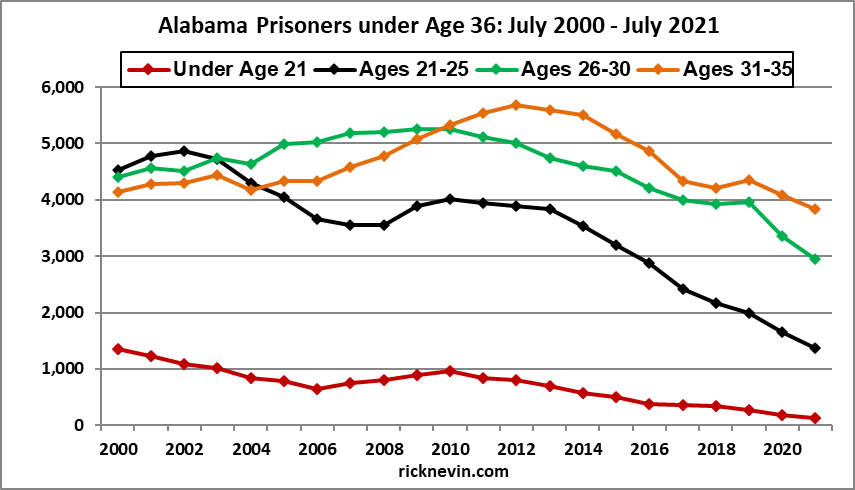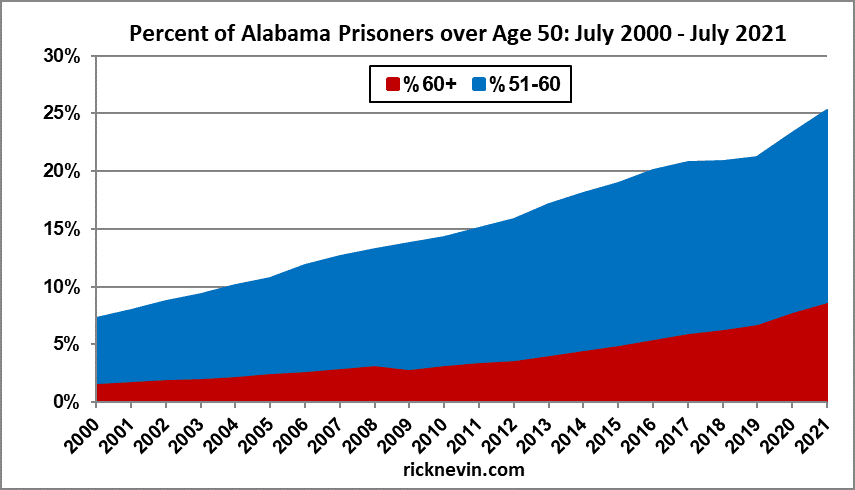Alabama’s Empty Prison Plan
Alabama lawmakers have passed legislation to build two new 4,000-bed prisons. This decision was made without any understanding of how and why Alabama’s prison population fell 23% from July 2012 through July 2021.
Alabama will fund the $1.34 billion cost of the two prisons with $400 million in federal Covid-19 relief funds, $154 million from the state General Fund, and a $785 million state bond issue with debt payments of $50 million a year for 30 years (al.com). The 30-year financing for this plan ignores the fact that Alabama prisons will empty out over the next 30 years.
Alabama prison data show that the number of prisoners under age 21 fell 91% from 2000 to 2021, as prisoners ages 21-25 fell 70%. The number of prisoners ages 26-30 peaked in 2009 and fell 44% from 2009-2021, for a net decline of 33% from 2000-2021. The number of prisoners ages 31-35 peaked in 2012 and fell 33% from 2012-2021, for a net decline of 8% from 2000-2021.

As the number of young prisoners plummeted from 2000-2021, prisoners ages 51-60 rose 203% and prisoners over age 60 rose 390%. As a result, the percent of Alabama prisoners who are over the age of 50 rose from 7% in 2000 to 25% in 2021.

National trends show the same patterns. From 2000-2019, USA male incarceration rates fell 74% for ages 18-19, 54% for ages 20-24, and 35% for ages 25-29, but rose 21% for ages 40-44. Data for older age groups, first reported in 2007, show male incarceration rates from 2007 to 2019 rose 79% for ages 55-59, and 82% for ages 60-64.
Incarceration trends by age reflect an astonishing collapse in offending by juveniles and young adults. From 1994 to 2019, violent crime arrest rates fell 73% for ages 15-17, and 65% for ages 18-20, but rose 21% for ages 50-54. From 1988-2019, felony property crime arrest rates fell 83% for ages 15-17, and 74% for ages 18-20, but rose 11% for ages 50-54.
Massive declines in youth incarceration have important implications for prison planning. The lifetime risk of going to prison drops by almost 60% if you haven’t gone to prison by age 30, and it drops 82% if you haven’t gone to prison by age 40. The vast majority of individuals sent to prison after age 40 have already served one or more prison terms before age 40. Recent recidivism data show the percent of prisoners released in 2012 who returned to prison within 5 years was 56.8% among those released before age 25, versus 24.5% among prisoners released at ages 55 to 64 and just 14.4% among those released at ages 65 and older. Therefore, the decline in Alabama prisoners under age 30 since 2000 means that Alabama can expect a corresponding decline in recidivist prisoners returning to prison over the next few decades, due to the inevitable decline in the number of younger prisoners released.
Almost two-thirds of those sent to prison for the first time have served a prior sentence to probation and a third have served a sentence in a jail or juvenile residential placement facility. The latest national data show ongoing declines in juvenile felony arrests, juveniles in adult jails, and juveniles sentenced to probation or residential placement. The number of Alabama juveniles in residential placement fell 55% from 2003 to 2019. Therefore, there is good reason to expect further declines in young adults sent to Alabama prisons.
A continuing decline in young adults going to prison for the first time, plus an inevitable decline in recidivist prisoners returning to prison, means there is good reason to expect an accelerating decline in Alabama’s prison population over the coming years. The folly of building new prisons at this time will be horribly obvious to Alabama taxpayers long before the last payment is made on a 30-year bond to fund prison construction.
